13 - Chick pea (Cicer arietinum)
Published online by Cambridge University Press: 05 June 2012
Summary
Taxonomy
The genus Cicer, of the monogeneric tribe Cicereae, includes about 40 species, distributed throughout central and western Asia. C. arietinum, an annual, is not known in the wild state. Most members of the genus, including chickpea, have 2n = 2x = 16, though 2n = 14 has also been reported for chickpea and two other species (Ramanujam, 1976). Only one wild species, C. reticulatum, crosses readily with cultivated chickpea, and may be its wild progenitor (Ladizinsky & Adler, 1976). The taxonomy of chickpea is summarised by Smartt (1990), who also reviews the evidence of domestication and evolution.
Agronomically, two main types, kabuli and desi, are recognised. The desi type is the one most widely grown in the tropics; it is of short stature and relatively short growth duration, with small, dark-coloured wrinkled seed. The kabuli type is characteristic of the Mediterranean region; it is taller and of longer growth duration, with large, lightcoloured and relatively unwrinkled seed.
Origin, evolution and dispersal
The main centre of diversity of the genus Cicer is the Caucasus and Asia Minor (van der Maesen, 1972, 1984). The forerunner of the present domesticate spread westward along the Mediterranean and eastward to India (Ramanujam, 1976). The earliest record, 6400 bp, is from Turkey. There is evidence of chickpea cultivation in the Mediterranean from 4000–6000 bp.
- Type
- Chapter
- Information
- The Ecology of Tropical Food Crops , pp. 240 - 254Publisher: Cambridge University PressPrint publication year: 1995



